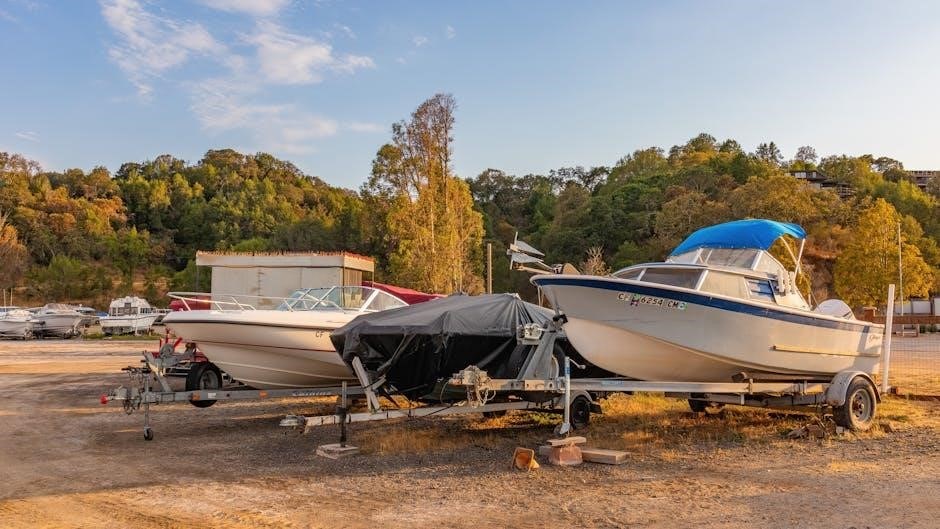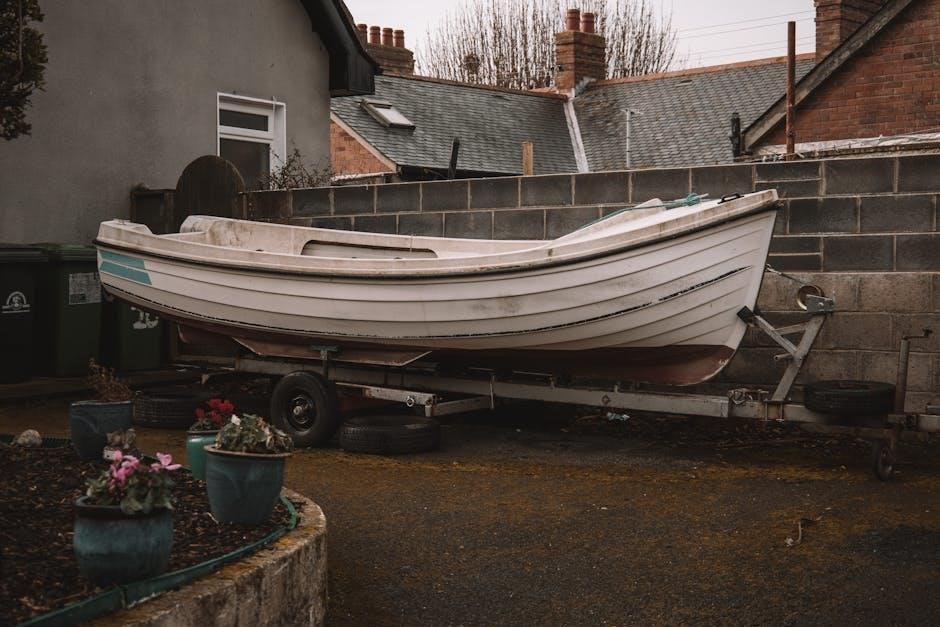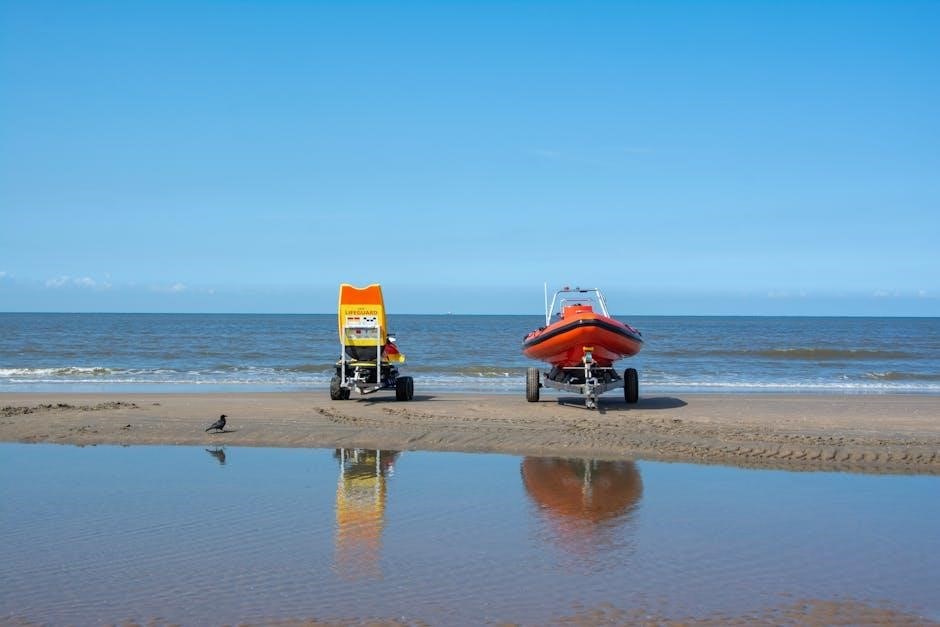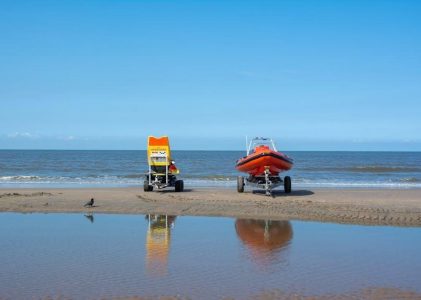Boat guides for trailers are essential accessories that simplify loading and unloading by providing clear alignment and visibility. They enhance safety, stability, and efficiency, especially when handling boats solo. Whether you’re a seasoned pro or a new boat owner, high-quality guides ensure a smoother experience every time.
Purpose and Importance of Boat Guides
Boat guides for trailers serve as alignment tools, helping to center the boat during loading and unloading. They improve visibility, reduce the risk of damage, and enhance overall safety. Guides are especially useful in windy or current-heavy conditions, providing stability and control. They also save time and effort, making the process more efficient for solo operators. Their importance lies in ensuring a smooth, stress-free experience for boat owners of all skill levels.
Common Challenges Without Proper Guides
Without proper boat guides, loading and unloading can be difficult, especially for solo operators. Misalignment often leads to boat damage or trailer wear. Windy or current-heavy conditions exacerbate these issues, increasing the risk of accidents. Additionally, poor visibility when backing up can result in improper positioning, causing frustration and delays. These challenges highlight the necessity of reliable guides for a safer and more efficient boating experience.
Types of Boat Guides for Trailers
Boat guides for trailers include posts, bunks, and poles, each offering unique benefits. Posts provide clear alignment, while bunks support the hull, and poles enhance visibility during loading.
Trailer Guide Posts vs. Bunks: Pros and Cons
Trailer guide posts and bunks both aid in boat loading but differ in functionality. Posts offer enhanced visibility and alignment, especially in windy or current conditions, making solo loading easier. Bunks provide hull support but may lack the guiding precision of posts. The choice depends on boat size, handling preferences, and specific challenges like crosswinds or currents during loading.
Guide Poles: Advantages and Installation Tips
Guide poles offer improved visibility and alignment, making trailer loading easier, especially for solo operators. They are durable and can withstand harsh conditions. Installation involves securing poles to the trailer frame and adjusting height and angle for optimal guidance. Proper placement ensures smooth boat centering, reducing the risk of damage or misalignment during loading and unloading.

Materials and Construction of Boat Guides
Boat guides are typically made from durable materials like heavy-duty steel, aluminum, or fiberglass, ensuring longevity and strength. Construction varies to suit different boat sizes and trailer types.
Common Materials Used for Durability
Durable materials like heavy-duty steel and marine-grade aluminum are commonly used for boat guides due to their strength and resistance to corrosion. Fiberglass is another option, offering lightweight durability. These materials ensure that guides can withstand harsh marine environments and heavy use, providing long-lasting reliability for safe and efficient boat handling during loading and unloading. Proper material selection is key for optimal performance.
Heavy-Duty Options for Large Boats
For larger boats, heavy-duty trailer guides are essential to ensure stability and control. Reinforced steel and marine-grade aluminum are popular choices, offering exceptional strength. Brands like West Marine provide heavy-duty solutions designed for boats over 25 feet. These guides often feature adjustable poles and robust mounting systems to handle the stress of larger vessels, especially in challenging conditions like cross winds and currents.
Installation and Adjustment of Boat Guides
Proper installation ensures secure mounting and alignment. Adjustments allow customization for boat size and trailer setup. Follow manufacturer guidelines for precise fitting and optimal performance.
Step-by-Step Installation Process
Assess your trailer and boat size to choose the right guides. Measure and mark installation points on the trailer frame. Attach brackets securely, ensuring proper alignment. Mount the guides, adjusting their height and angle for optimal fit. Tighten all hardware firmly. Test the system by loading and unloading the boat to ensure smooth operation and proper alignment. Adjust as needed for precise fit.
Adjusting Guides for Different Boat Sizes
Adjusting boat guides ensures proper alignment for various boat sizes. Measure the boat’s width and position the guides accordingly. For smaller boats, narrow the guide spacing, while larger boats require wider adjustments. Ensure the guides are level and securely attached to the trailer frame for stability. Fine-tune the height to match the boat’s hull contour, providing smooth, even support during loading and unloading. Regularly check and adjust for optimal performance.
Choosing the Right Boat Guides
Choosing the right boat guides is crucial for efficient and safe boat handling. Consider boat size, trailer type, and personal preference to select the best option for your specific needs.
Factors to Consider: Boat Size and Trailer Type
When selecting boat guides, consider your boat’s size and trailer type. Larger boats, like sailfish or bass boats, require heavy-duty guides for stability. Smaller boats, such as aluminum bass boats, may benefit from lightweight options. Trailer type also plays a role, as some guides are designed for specific trailer setups, ensuring proper alignment and ease of use during loading and unloading.
Personal Preference and Usage Scenarios
Personal preference often dictates the choice between guide posts or bunks, with some favoring visibility and others prioritizing durability. Usage scenarios, such as frequent solo loading or handling large boats in windy conditions, also influence decisions. For instance, guide posts are preferred for clear alignment, while bunks offer stability for rough handling, catering to different boating lifestyles and needs.
Using Boat Guides Effectively
Effective use of boat guides involves proper alignment, steady movement, and clear visibility. They simplify solo loading and unloading, ensuring a smooth and stress-free experience every time.
Techniques for Loading and Unloading Solo
When loading or unloading solo, align the boat’s centerline with the trailer’s guides. Use slow, steady movements and maintain visual contact with the guides. For unloading, ensure the trailer is submerged just enough for the boat to float free. Practice in calm conditions to build confidence and master the technique for seamless solo handling every time.
Expert Tips for Smooth Boat Handling
Experts recommend using guide poles for enhanced visibility when reversing. Ensure the trailer is aligned with the boat’s centerline and adjust guides seasonally for optimal performance. Regularly inspect and lubricate moving parts to maintain smooth operation. Always practice in calm conditions before tackling challenging environments, and consider using a spotter for added safety, especially when handling larger boats or in busy areas.
Maintenance and Care of Boat Guides
Maintaining boat guides involves regular cleaning and lubrication to prevent rust and wear. Inspect for damage, replace worn parts, and secure guides during transport to ensure longevity and reliability.
Cleaning and Inspection Tips
Regularly clean boat guides with mild detergent and water to remove dirt and saltwater residue. Inspect for rust, dents, or wear, and lubricate moving parts to maintain smooth operation. Check for loose bolts and tighten them as needed. Store guides dry during off-season to prevent corrosion. Replace damaged or worn components promptly to ensure optimal performance and safety.
Seasonal Preparation and Storage
Before storing boat guides, clean and dry them thoroughly to prevent corrosion. Apply a rust-inhibiting coating and lubricate hinges or moving parts. Store in a dry, protected area away from direct sunlight; Cover guides to shield from dust and debris. Regularly inspect stored guides for damage or wear. Proper storage ensures longevity and optimal performance when back in use.

Safety Considerations with Boat Guides
Ensure guides are securely attached to avoid detachment during transit. Always inspect for damage or wear before use. Proper alignment prevents accidents and ensures safe boat handling.
Preventing Accidents During Loading
Properly aligned boat guides minimize the risk of accidents during loading by providing clear visibility and stability. Using durable materials ensures reliability, while regular inspections prevent equipment failure. Always maintain a steady pace and ensure the ramp is clear of obstacles to enhance safety. These precautions help avoid costly damages and ensure a smooth process every time.
Best Practices for Safe Boat Handling
Ensure the trailer and boat are properly aligned using guides before loading or unloading; Always maintain a steady speed and communicate clearly with anyone assisting. Secure the boat firmly to the trailer and check all straps and chains. Use guide poles for enhanced visibility, especially in windy or current-prone conditions. Regular maintenance of guides ensures they remain effective and reliable for every outing.

Reviews and Recommendations
Popular brands like West Marine offer heavy-duty guides, ideal for larger boats. Forums recommend guide posts for better alignment in windy conditions, enhancing visibility and durability during loading.
Popular Brands and User Feedback
West Marine and other reputable brands offer durable guides, with users praising their heavy-duty designs for larger boats. Forum discussions highlight preferences for guide posts over bunks due to better alignment and visibility. Many users appreciate the enhanced stability and ease of loading, especially in windy or currents conditions, making these accessories a worthwhile investment for boat owners seeking reliability and efficiency.
Community Recommendations and Experiences
Online forums like JetBoaters.Net and Bass Fishing Forums reveal that many boat owners swear by guide posts for their trailers. Users highlight improved alignment and reduced stress during loading, especially in windy or current-prone areas. Homemade solutions are also popular, with DIY enthusiasts sharing creative setups. Overall, the boating community emphasizes the importance of sturdy, reliable guides that enhance both safety and efficiency.
DIY Solutions for Boat Guides
Boat owners often opt for homemade guides using u-clamps, metal poles, or wooden planks. These cost-effective solutions provide visibility and alignment, enhancing trailer usability creatively.
Materials and Tools Needed
Common materials for homemade guides include u-clamps, metal poles, or wooden planks. Tools like drills, saws, and measuring tapes are essential for installation. Durable materials such as stainless steel or aluminum are recommended for long-lasting performance. Ensure all components are weather-resistant to withstand outdoor conditions and heavy use.
Basic Steps for Homemade Guides
Start by measuring your trailer and boat to determine guide placement. Attach u-clamps or brackets to the trailer frame for stability. Secure poles or planks to these brackets, ensuring they extend above the trailer sides. Adjust the guides to align with your boat’s centerline for proper alignment. Test the setup during loading to ensure smooth operation and make necessary adjustments for optimal performance.
Boat guides for trailers enhance safety, efficiency, and ease of use. Properly chosen and maintained, they ensure smooth boat handling and protect your investment. Invest wisely for lasting benefits.
Final Thoughts and Encouragement to Act
Investing in quality boat guides for trailers is a smart decision that enhances safety, efficiency, and overall boating experiences. By selecting the right guides tailored to your boat’s size and trailer type, you ensure smoother loading, unloading, and protection of your vessel. Take action today to upgrade your setup and enjoy hassle-free boating adventures tomorrow.

